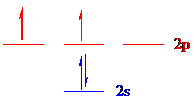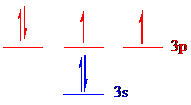
Determine the number of unpaired electrons in each of the following atoms in the ground state and identify each as diamagnetic or paramagnetic: (a) C, (b) S, (c) Cu, (d) Pb, (e) Ti.
(a)
Interpretation:
The number of unpaired electrons in the given atoms with its diamagnetic or paramagnetic behaviour should be given by knowing their ground-state electron configurations.
Concept Introduction:
An orbital is an area of space in which electrons are orderly filled. The maximum capacity in any type of orbital is two electrons. An atomic orbital is defined as the region of space in which the probability of finding the electrons is highest. It is subdivided into four orbitals such as
There are three basic principles in which orbitals are filled by the electrons.
- 1. Aufbau principle: In German, the word 'aufbau' means 'building up'. The electrons are arranged in various orbitals in the order of increasing energies.
- 2. Pauli exclusion principle: An electron does not have all the four quantum numbers.
- 3. Hund’s rule: Each orbital is singly engaged with one electron having the maximum same spin capacity after that only pairing occurs.
The electron configuration is the allocation of electrons of an atom in atomic orbitals. Electronic configuration of a particular atom is written by following the three basic principles. If all the atomic orbitals are filled by electrons, then the atom is diamagnetic in nature. Diamagnetic atoms are repelled by the magnetic field. If one or more unpaired electrons are present in an atom, then that atom is paramagnetic in nature. Paramagnetic atoms are attracted to the magnetic field.
To find: Count the number of unpaired electrons in
Answer to Problem 3.104QP
The number of unpaired electrons in
Explanation of Solution
Carbon (
The noble gas core for
Put all the electrons in the atomic orbitals by following Aufbau principle, Pauli exclusion principle and Hund’s rule.

The 4 electrons of carbon (
The unpaired electrons are present in
(b)
Interpretation:
The number of unpaired electrons in the given atoms with its diamagnetic or paramagnetic behavior should be given by knowing their ground-state electron configurations.
Concept Introduction:
An orbital is an area of space in which electrons are orderly filled. The maximum capacity in any type of orbital is two electrons. An atomic orbital is defined as the region of space in which the probability of finding the electrons is highest. It is subdivided into four orbitals such as
There are three basic principles in which orbitals are filled by the electrons.
- 1. Aufbau principle: In German, the word 'aufbau' means 'building up'. The electrons are arranged in various orbitals in the order of increasing energies.
- 2. Pauli exclusion principle: An electron does not have all the four quantum numbers.
- 3. Hund’s rule: Each orbital is singly engaged with one electron having the maximum same spin capacity after that only pairing occurs.
The electron configuration is the allocation of electrons of an atom in atomic orbitals. Electronic configuration of a particular atom is written by following the three basic principles. If all the atomic orbitals are filled by electrons, then the atom is diamagnetic in nature. Diamagnetic atoms are repelled by the magnetic field. If one or more unpaired electrons are present in an atom, then that atom is paramagnetic in nature. Paramagnetic atoms are attracted to the magnetic field.
To find: Count the number of unpaired electrons in
Answer to Problem 3.104QP
The number of unpaired electron in
Explanation of Solution
The noble gas core for
Put all the electrons in the atomic orbitals by following Aufbau principle, Pauli exclusion principle and Hund’s rule.

All the 6 electrons of
The unpaired electrons are present in
(c)
Interpretation:
The number of unpaired electrons in the given atoms with its diamagnetic or paramagnetic behavior should be given by knowing their ground-state electron configurations.
Concept Introduction:
An orbital is an area of space in which electrons are orderly filled. The maximum capacity in any type of orbital is two electrons. An atomic orbital is defined as the region of space in which the probability of finding the electrons is highest. It is subdivided into four orbitals such as
There are three basic principles in which orbitals are filled by the electrons.
- 1. Aufbau principle: In German, the word 'aufbau' means 'building up'. The electrons are arranged in various orbitals in the order of increasing energies.
- 2. Pauli exclusion principle: An electron does not have all the four quantum numbers.
- 3. Hund’s rule: Each orbital is singly engaged with one electron having the maximum same spin capacity after that only pairing occurs.
The electron configuration is the allocation of electrons of an atom in atomic orbitals. Electronic configuration of a particular atom is written by following the three basic principles. If all the atomic orbitals are filled by electrons, then the atom is diamagnetic in nature. Diamagnetic atoms are repelled by the magnetic field. If one or more unpaired electrons are present in an atom, then that atom is paramagnetic in nature. Paramagnetic atoms are attracted to the magnetic field.
To find: Count the number of unpaired electrons in
Answer to Problem 3.104QP
The number of unpaired electron in
Explanation of Solution
The noble gas core for
Put all the 11 electrons in the atomic orbitals by following Aufbau principle, Pauli exclusion principle and Hund’s rule.

All the 11 electrons of
The unpaired electron is present in
(d)
Interpretation:
The number of unpaired electrons in the given atoms with its diamagnetic or paramagnetic behavior should be given by knowing their ground-state electron configurations.
Concept Introduction:
An orbital is an area of space in which electrons are orderly filled. The maximum capacity in any type of orbital is two electrons. An atomic orbital is defined as the region of space in which the probability of finding the electrons is highest. It is subdivided into four orbitals such as
There are three basic principles in which orbitals are filled by the electrons.
- 1. Aufbau principle: In German, the word 'aufbau' means 'building up'. The electrons are arranged in various orbitals in the order of increasing energies.
- 2. Pauli exclusion principle: An electron does not have all the four quantum numbers.
- 3. Hund’s rule: Each orbital is singly engaged with one electron having the maximum same spin capacity after that only pairing occurs.
The electron configuration is the allocation of electrons of an atom in atomic orbitals. Electronic configuration of a particular atom is written by following the three basic principles. If all the atomic orbitals are filled by electrons, then the atom is diamagnetic in nature. Diamagnetic atoms are repelled by the magnetic field. If one or more unpaired electrons are present in an atom, then that atom is paramagnetic in nature. Paramagnetic atoms are attracted to the magnetic field.
To find: Count the number of unpaired electrons in
Answer to Problem 3.104QP
The number of unpaired electron in
Explanation of Solution
The noble gas core for
Put all the 28 electrons in the atomic orbitals by following Aufbau principle, Pauli exclusion principle and Hund’s rule.

All the 28 electrons of
The unpaired electrons are present in
(e)
Interpretation:
The number of unpaired electrons in the given atoms with its diamagnetic or paramagnetic behavior should be given by knowing their ground-state electron configurations.
Concept Introduction:
An orbital is an area of space in which electrons are orderly filled. The maximum capacity in any type of orbital is two electrons. An atomic orbital is defined as the region of space in which the probability of finding the electrons is highest. It is subdivided into four orbitals such as
There are three basic principles in which orbitals are filled by the electrons.
- 1. Aufbau principle: In German, the word 'aufbau' means 'building up'. The electrons are arranged in various orbitals in the order of increasing energies.
- 2. Pauli exclusion principle: An electron does not have all the four quantum numbers.
- 3. Hund’s rule: Each orbital is singly engaged with one electron having the maximum same spin capacity after that only pairing occurs.
The electron configuration is the allocation of electrons of an atom in atomic orbitals. Electronic configuration of a particular atom is written by following the three basic principles. If all the atomic orbitals are filled by electrons, then the atom is diamagnetic in nature. Diamagnetic atoms are repelled by the magnetic field. If one or more unpaired electrons are present in an atom, then that atom is paramagnetic in nature. Paramagnetic atoms are attracted to the magnetic field.
To find: Count the number of unpaired electrons in
Answer to Problem 3.104QP
The number of unpaired electron in
Explanation of Solution
The noble gas core for
Put all the electrons in the atomic orbitals by following Aufbau principle, Pauli exclusion principle and Hund’s rule.

The four electrons of
The unpaired electrons are present in
Want to see more full solutions like this?
Chapter 3 Solutions
CHEMISTRY:ATOMS FIRST (LL)>CUSTOM PKG.<
- Calculate the total amount of heat transferred as 50 g of Water -10°C. Calculate the total amount of heat transferred as 25 g of water is heated from 50°C to 100°C as a gas. \table[[Specific heat H₂O(g), 2.00°C Η 2 g 5. Calculate the total amount of heat transferred as 50 g of wat Specific heat H₂O (g) 2.00 J/g°C -10 °C. 4.18 J/g°C 2.11 J/g°C 2260 J/g 334 J/g Specific heat H₂O (1) Specific heat H₂O (s) Heat of vaporization Heat of fusion Melting point 6. Calculate the total amount of heat transferred as 25 g of water is heated from 50 °C to 100 °C as a gas. Boiling point 100 °C 0°Carrow_forwardWrite formulas for ionic compounds composed of the following ions. Use units as a guide to your solutions. 24. sodium and nitrate 25. calcium and chlorate 26. aluminum and carbonate 27. CHALLENGE Write the formula for an ionic compound formed by ions from a group 2 element and polyatomic ions composed of only carbon and oxygen.show work step by steparrow_forwardADDITIONAL PRACTICE PRACTICE Problems Write formulas for ionic compounds composed of the following ions. Use units as a guide to your solutions. 24. sodium and nitrate 25. calcium and chlorate 26. aluminum and carbonate 27. CHALLENGE Write the formula for an ionic compound formed by ions from a group 2 element and polyatomic ions composed of only carbon and oxygen. ounds 1998arrow_forward
- 7:35 < Dji Question 19 of 22 5G 50% Submit What is the pH of a buffer made from 0.350 mol of HBrO (Ka = 2.5 × 10-9) and 0.120 mol of KBRO in 2.0 L of solution? | 1 2 3 ☑ 4 5 6 C 7 8 ☐ 9 +/- Tap here for additional resources ||| 0 ×10 Гarrow_forwardaw the major substitution products you would expect for the reaction shown below. If substitution would not occur at a significant rate under these conditions, check the box underneath the drawing area instead. Be sure you use wedge and dash bonds where necessary, for example to distinguish between major products. Note for advanced students: you can assume that the reaction mixture is heated mildly, somewhat above room temperature, but strong heat or reflux is not used. B C Br HO O Substitution will not occur at a significant rate. Explanation Check + Х Click and drag to start drawing a structure. © 2025 McGraw Hill LLC. All Rights Reserved. Terms of Use | Privacy Center | Accessibarrow_forwardComplete the following reactions with the necessary reagents to complete the shown transformation. Example: 1. 2. ? 3. 018 Br OH Answer: H₂O, H2SO4, HgSO4arrow_forward
- 7:34 • < Question 18 of 22 5G 50% Submit What is the pH of a buffer made from 0.220 mol of HCNO (Ka = 3.5 × 10-4) and 0.410 mol of NaCNO in 2.0 L of solution? 1 2 3 ☑ 4 5 6 C 7 8 | 9 +/- 0 ×10 Tap here for additional resources ||| Гarrow_forward6:46 ✔ 5G 58% < Question 7 of 22 Submit What is the primary species in solution at the halfway point in a titration of NH3 with HBr? A NH3 and H+ B NH₁+ and H+ C NH4+ D NH3 and NH4+ Tap here for additional resources |||arrow_forward6:49 Dji < Question 15 of 22 4G 57% Submit The pOH of a solution is 10.50. What is the OH- concentration in the solution? A 3.2 × 10-4 M B C 3.2 x 10-11 M 10.50 M D 4.2 M E 3.50 M Tap here for additional resources |||arrow_forward
- ヨ 6:49 Dji < Question 13 of 22 5G 57% Submit The pH of a solution is 2.40. What is the H+ concentration in the solution? A B 2.5 x 10-12 M 4.0 × 10-3 M C 2.40 M D 4.76 M 11.60 M Tap here for additional resources |||arrow_forwardヨ C 6:48 Di✔ < Question 12 of 22 5G 57% Submit The pH of a solution is 12.50. What is the H+ concentration in the solution? A 0.032 M B 3.2 × 10-13 M 1.5 M D 9.25 M 12.50 M Tap here for additional resources |||arrow_forwardヨ C 6:48 Di✔ < Question 11 of 22 5G 57% Submit The pH of a solution is 1.50. What is the H+ concentration in the solution? A 0.032 M B 3.2 × 10-13 M 1.5 M D 2.15 M 12.50 M Tap here for additional resources |||arrow_forward

 ChemistryChemistryISBN:9781305957404Author:Steven S. Zumdahl, Susan A. Zumdahl, Donald J. DeCostePublisher:Cengage Learning
ChemistryChemistryISBN:9781305957404Author:Steven S. Zumdahl, Susan A. Zumdahl, Donald J. DeCostePublisher:Cengage Learning Chemistry: An Atoms First ApproachChemistryISBN:9781305079243Author:Steven S. Zumdahl, Susan A. ZumdahlPublisher:Cengage Learning
Chemistry: An Atoms First ApproachChemistryISBN:9781305079243Author:Steven S. Zumdahl, Susan A. ZumdahlPublisher:Cengage Learning General Chemistry - Standalone book (MindTap Cour...ChemistryISBN:9781305580343Author:Steven D. Gammon, Ebbing, Darrell Ebbing, Steven D., Darrell; Gammon, Darrell Ebbing; Steven D. Gammon, Darrell D.; Gammon, Ebbing; Steven D. Gammon; DarrellPublisher:Cengage Learning
General Chemistry - Standalone book (MindTap Cour...ChemistryISBN:9781305580343Author:Steven D. Gammon, Ebbing, Darrell Ebbing, Steven D., Darrell; Gammon, Darrell Ebbing; Steven D. Gammon, Darrell D.; Gammon, Ebbing; Steven D. Gammon; DarrellPublisher:Cengage Learning Introductory Chemistry: An Active Learning Approa...ChemistryISBN:9781305079250Author:Mark S. Cracolice, Ed PetersPublisher:Cengage Learning
Introductory Chemistry: An Active Learning Approa...ChemistryISBN:9781305079250Author:Mark S. Cracolice, Ed PetersPublisher:Cengage Learning Chemistry: Principles and ReactionsChemistryISBN:9781305079373Author:William L. Masterton, Cecile N. HurleyPublisher:Cengage Learning
Chemistry: Principles and ReactionsChemistryISBN:9781305079373Author:William L. Masterton, Cecile N. HurleyPublisher:Cengage Learning





